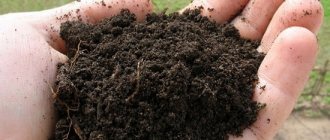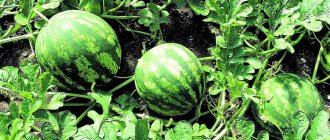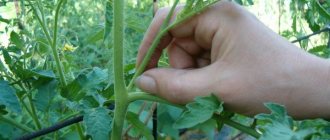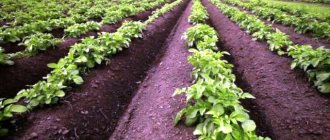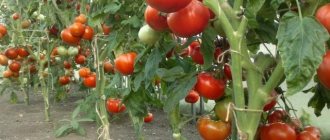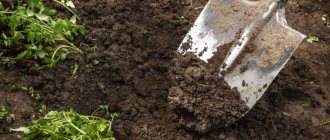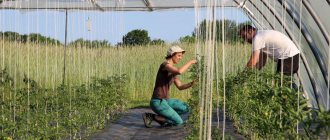Tomatoes are grown in open ground and in greenhouse conditions. It is best, of course, to use a greenhouse for such purposes. After all, the weather is often unpredictable and capricious. And every vegetable grower wants to get a rich harvest.
In addition to warmth, for good fruiting, the plant also needs the right soil. This article will tell you how to prepare the ground for planting tomatoes.
What kind of land should there be for growing tomatoes?
The peculiarity of soil for tomatoes in a greenhouse is that it wears out very quickly and becomes unusable. The soil for tomatoes in a greenhouse should be loose and moisture-retaining.
The soil for planting tomatoes in open ground should be warmed up (approximately mid-April). The beds are made wide and humus is added. To stretch the film in case of frost, arcs are installed. Sufficient space should be left between rows.
Requirements
The soil must contain all the necessary components for growing tomatoes.
Soil for tomatoes for their proper growth must contain the following elements:
- nitrogen;
- phosphorus;
- potassium.
It is necessary that these minerals be in an easily digestible form. In a certain part, the greenhouse soil should consist of sand, as this is necessary for the development of the skeletal part of the plant.
The soil must be loose, since the roots located on the surface cannot tolerate waterlogging and grow only in the loose substance, extracting nutrients from a larger area. If there are such characteristics as water permeability and moisture capacity, the soil retains moisture well, but does not become swampy. Also, for comfortable growth of tomatoes, heat capacity is required .
In addition, when preparing the soil, it should be as neutralized as possible from infections and free from pest larvae.
The soil should not contain weed seeds.
What acidity should it be?
Tomatoes love soil with an acidity of 6.2 to 6.8 pH . To determine soil acidity, use a set of indicator tests (litmus tests), which are sold in gardening stores.
Read about what acidity the soil for tomatoes should be and how to ensure their high yield.
Tillage
Autumn soil preparation in a greenhouse for tomatoes consists of several steps:
- In the fall, it is necessary to remove the remains of all plants, or better yet, remove them by the roots. The remaining plant debris retains parasites and outbreaks of disease until spring.
- Garters and trellises must be removed for the winter.
- Rinse the greenhouse frame and fencing with a hose. If there have been cases of pests or infections, treat the structure with a solution of bleach: 400 g per bucket of water.
- Prepare fertilizers: compost, humus. Scatter one bucket per 1 m2 over the garden bed. It’s good to dig up the beds along with organic matter.
- Apply potassium and phosphorus preparations, use a pitchfork or hoe to plant them to a depth of 5-7 cm, at the same time loosening the soil and removing small weeds.
Screening
Sifting is used as an additional measure of loosening, structuring and oxygen saturation. At the same time, it is possible to get rid of pebbles, remnants of roots and other debris. It is easier to transplant seedlings into sifted soil; the roots of the sprouts are not injured.
For sifting, meshes with a cell size of 6-12 mm are used. You can also use a construction sieve.
Temperature treatment
Temperature treatment destroys insect pests and their larvae, fungal spores, and pathogens.
The most common technique is freezing the soil. To do this, the covering is removed from film greenhouses, and buildings made of polycarbonate or glass are left open. After freezing, the soil is covered with a layer of snow.
Spilling boiling water over the beds kills pathogenic organisms and warms the soil. This method is used only in the spring before planting seedlings.
Homemade mixtures
If it is not possible to use purchased mixtures, you can prepare the soil for the greenhouse yourself.
In the fall, after harvesting, you should remove the remaining greenery and carefully dig up the soil, freeing it from the roots of previous plants. The prepared soil needs to be checked for moisture: make a lump, and if it crumbles, then everything is in order. The soil made for the greenhouse should smell like earth (without third-party odors).
Benefits of homemade soil:
- You can prepare it according to the exact recipe and maintain the exact amount of microelements you need.
- Saving money.
Flaws:
- Long cooking time.
- You need to follow the recipe exactly.
- The soil may be contaminated.
- Finding and purchasing the right sweeping components can take a lot of time and money.
We invite you to watch a video on how to prepare soil for a greenhouse with your own hands:
Disinfection
Disinfection is necessary in order to destroy pathogens. There are various ways to clean seedling soil. One of them is freezing. Other methods include disinfectants and steam treatment.
- Method one. The prepared earthen mixture is watered with a solution of potassium permanganate (3 g per 10 liters of water), and then additionally treated with antifungal drugs.
- Method two. The seedling soil is placed in a fabric bag or perforated container and left to steam for 45 minutes. You can calcinate the soil in the oven, but then the necessary nutrients will disappear along with the pathogenic microbes.
Reference! Once disinfection has been carried out, seed material can be added to the soil nutrient mixture.
Ready-made formulations
When purchasing ready-made primer, it is impossible to know how correctly it was made and what it came into contact with. Therefore, it should be treated with a solution called “Fitolavin”, 2 ml per liter of water. The basis of purchased soil is most often peat.
Advantages of purchased soil for tomatoes:
- It is ready for use without additional processing.
- Rich in microelements and other components.
- This is a light and moisture-absorbing type of soil.
- You can choose bags of different capacities - from 1 to 50 liters.
Flaws:
- Nutrient contents are inaccurate (they are given as a range).
- Approximate pH level.
- Sometimes peat dust is added instead of peat.
- There is a risk of purchasing low-quality material.
Required Components
The main components of the earth mixture:
- turf or garden soil;
- non-acidic peat (pH 6.5);
- sand (washed or river);
- humus or sifted mature compost;
- sifted wood ash (you can use dolomite flour).
The simplest and optimal composition of the soil mixture for tomatoes will be obtained if you mix:
- 2 parts peat;
- 1 part of garden land;
- 1 part humus (or compost);
- 0.5 parts sand.
Peat usually has a higher acidity, so add the following to a bucket of the resulting mixture:
- 1 cup wood ash;
- 3 - 4 tablespoons of dolomite flour;
- 10 g urea;
- 30 - 40 g superphosphate;
- 10 - 15 g of potassium fertilizer.
Fertilizers can be replaced with a complex fertilizer containing more phosphorus and potassium, and less nitrogen.
Unacceptable additives
Do not use organic fertilizers that are in the process of decomposition . This releases a large amount of heat, which can burn the seeds (and even if they manage to sprout, they will still die from the high temperature).
Clay admixtures are not used, as they make the soil denser and heavier. Heavy metals quickly accumulate in the soil, so you should not use soil located near a busy highway or on the territory of a chemical plant. It is necessary to ensure that the soil in which tomatoes will grow is as clean as possible.
How to prepare soil mixture at home for tomatoes?
When purchasing a ready-made soil mixture, there is a chance to get acidic peat soil. Even with the addition of mineral fertilizers, the required development of tomato seeds intended for sowing in seedling soil may not be obtained. For this reason, seedling soil for tomatoes is made manually by experienced summer residents.
How to prepare soil for tomato seedlings at home? It is prepared by mixing. To do this, polyethylene is spread on the ground and each component is poured in the required proportions.
Seedling soil is produced as follows:
- To one part of the turf land, one part of peat and river sand is added.
- The resulting mixture is thoroughly mixed and then watered with a nutrient solution consisting of 25-30 grams of superphosphate, potassium sulfate and 10 grams of urea per 10 liters of water.
Another variant:
- Turf soil, peat and humus are mixed in equal proportions.
- Then it is done like this: two matchboxes of superphosphate and half a liter of can of ash are added to one bucket of substrate.
At the initial stage of seed germination, they do not require many microelements. Therefore, you should not excessively use fertilizers when preparing the soil for seedlings; the original soil is nutritious in itself. Fertilizers are required at the moment when the first leaves appear. Additional nutrition in liquid form is usually applied several weeks after germination.
Which is better to use?
For high yields in greenhouse soil there must be:
- Optimal heat exchange.
- Air permeability.
- The ability to become saturated with moisture during watering.
- The ability to absorb all the necessary substances and minerals.
Greenhouse soil contains:
- humus;
- compost;
- turf soil;
- sand;
- peat;
- calcareous rocks.
Humus is used as natural fuel.
Composition of humus:
- Phosphoric acid.
- Calcium oxide.
- Nitrogen.
- Potassium oxide.
All of the above elements are beneficial for the plant.
Properties of humus:
- Nourishes with minerals.
- Provides nutrients for microorganisms to enter the soil.
- Earth mixed with humus conducts air well.
- Turf is also important for tomato growth.
Sod soil:
- Formulated with plant root residues.
- Increases moisture absorption of the environment in which the plant develops.
Useful video
We invite you to watch a video about the rules for preparing soil for planting tomatoes in a greenhouse:
If you want to grow healthy tomatoes, then you need to take care of the soil for seedlings, which you can prepare yourself, thanks to the articles on our website.
Bacterial cocktail
A bacterial cocktail is a collection of bacteria beneficial to the soil. You should start preparing such a healthy drink for the soil 3-4 months before planting.
The bacteria act so that the soil is saturated with nitrogen, which has a beneficial effect on the growth of tomatoes and an increase in the number and quality of the harvest. A concentrated solution for preparing a cocktail can be purchased at any specialty store. It is sold in ampoules, one is enough for a greenhouse up to 600 square meters. m.
Rules for preparing and using a bacterial cocktail:
- If you plan to plant plants in a greenhouse in early March, then you need to prepare a bacterial cocktail in early November. 3-4 months before preparing the soil for the opening of a new summer season, dilute the ampoule in two liters of warm water. Add a spoonful of honey to the solution. Place the resulting mixture in a 10-liter container and close the lid tightly. The prepared solution should be stored for 3 months in a warm and dark place.
- A month before planting the plants, this solution diluted in water must be poured over all the soil in the greenhouse.
After a month, you can safely plant seeds or seedlings in soil fertilized with a bacterial cocktail. During this time, all the elements necessary for plants will be concentrated in it as much as possible, but the chemical additives will disappear and will not harm the tomatoes in any way.
